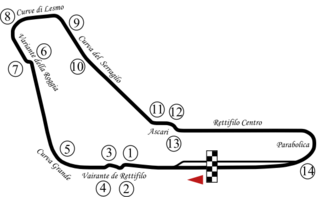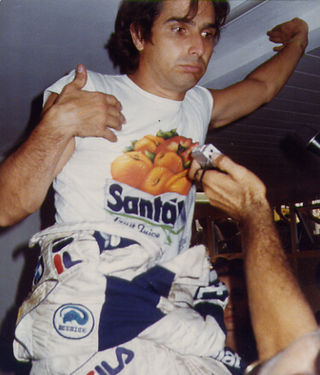
Gerhard Berger is an Austrian former Formula One racing driver. He competed in Formula One for 14 seasons, twice finishing 3rd overall in the championship, both times driving for Ferrari. He won ten Grands Prix, achieved 48 podiums, 12 poles and 21 fastest laps.

The 1987 San Marino Grand Prix was a Formula One motor race held on 3 May 1987 at the Autodromo Dino Ferrari, Imola. It was the second race of the 1987 Formula One season. It was the seventh San Marino Grand Prix and it was held over 59 laps of the five kilometre circuit for a race distance of 297 kilometres.

The 1987 Australian Grand Prix was a Formula One motor race held at Adelaide on 15 November 1987. It was the sixteenth and final race of the 1987 Formula One World Championship.

The 1988 San Marino Grand Prix was a Formula One motor race held at Imola on 1 May 1988. The 60-lap race was the second round of the 1988 Formula One season. Ayrton Senna scored his first victory for the McLaren team, with turbocharged Honda-powered cars sweeping the top three positions.
The 1988 Canadian Grand Prix was a Formula One motor race held on 12 June 1988 at the Circuit Gilles Villeneuve, Montreal. It was the fifth race of the 1988 Formula One World Championship. The 69-lap race was won from pole position by Brazilian driver Ayrton Senna, driving a McLaren-Honda, with French teammate Alain Prost second and Belgian Thierry Boutsen third in a Benetton-Ford.

The 1989 San Marino Grand Prix was a Formula One motor race held at the Imola circuit on 23 April 1989. It was the second race of the 1989 Formula One season. The race was overshadowed by Gerhard Berger's massive accident at Tamburello corner. The race was stopped for one hour and restarted. The race was won by Ayrton Senna who started from pole position. The Grand Prix had a total of 39 entrants, the largest amount in Formula One history. This record was equalled in the following 14 races of the season but, as of 2022, it has not been broken.

The 1990 San Marino Grand Prix was a Formula One motor race held on 13 May 1990 at Imola. It was the third race of the 1990 Formula One World Championship. The race was held over 61 laps of the 5.04-kilometre (3.13 mi) circuit for a race distance of 307.44 kilometres (191.03 mi).

The 1990 German Grand Prix was a Formula One motor race held at the Hockenheimring on 29 July 1990. It was the ninth race of the 1990 Formula One World Championship. The race was the 52nd German Grand Prix and the 14th to be held at the Hockenheimring. It was the 39th and last Formula One Grand Prix to be held in West Germany prior to its re-unification with East Germany. The race was held over 45 laps of the seven kilometre circuit for a race distance of 306 kilometres.

The 1990 Australian Grand Prix was a Formula One motor race held at Adelaide on 4 November 1990. It was the sixteenth and final race of the 1990 Formula One World Championship, and the 500th race to contribute to the World Drivers' Championship since the series started in 1950. The race was the 55th Australian Grand Prix, and the sixth to be part of the Formula One World Championship. It was held over 81 laps of the 3.78-kilometre (2.35 mi) circuit for a race distance of 306 kilometres (190 mi).

The 1991 Italian Grand Prix was a Formula One motor race held at Monza on 8 September 1991. It was the twelfth race of the 1991 Formula One World Championship.

The 1992 San Marino Grand Prix was a Formula One motor race held at Imola on 17 May 1992. It was the fifth race of the 1992 Formula One World Championship.

The 1993 San Marino Grand Prix was a Formula One motor race held at Imola on 25 April 1993. It was the fourth race of the 1993 Formula One World Championship.

The 1995 San Marino Grand Prix was a Formula One motor race held on 30 April 1995 at the Autodromo Enzo e Dino Ferrari, Imola. It was the third race of the 1995 Formula One season.

The 1991 FIA Formula One World Championship was the 45th season of FIA Formula One motor racing and the 42nd season of the Formula One World Championship. It featured the 1991 Formula One World Championship for Drivers and the 1991 Formula One World Championship for Constructors, which were contested concurrently over a sixteen-race series that commenced on 10 March and ended on 3 November.

The 1990 FIA Formula One World Championship was the 44th season of FIA Formula One motor racing. It featured the 1990 Formula One World Championship for Drivers and the 1990 Formula One World Championship for Constructors, which were contested concurrently over a sixteen-race series that commenced on 11 March and ended on 4 November. Ayrton Senna won the Drivers' Championship for the second time, and McLaren-Honda won their third consecutive Constructors' Championship.

The 1989 FIA Formula One World Championship was the 43rd season of FIA Formula One motor racing. It began on 26 March and ended on 5 November. Alain Prost won his third Drivers' Championship, and McLaren won the Constructors' Championship.

The 1988 FIA Formula One World Championship was the 42nd season of FIA Formula One motor racing. It featured the 1988 Formula One World Championship for Drivers and the 1988 Formula One World Championship for Constructors, which were contested concurrently over a sixteen-race series that commenced on 3 April and ended on 13 November. The World Championship for Drivers was won by Ayrton Senna, and the World Championship for Constructors by McLaren-Honda. Senna and McLaren teammate Alain Prost won fifteen of the sixteen races between them; the only race neither driver won was the Italian Grand Prix, where Ferrari's Gerhard Berger took an emotional victory four weeks after the death of team founder Enzo Ferrari. McLaren's win tally has only been bettered or equalled in seasons with more than sixteen races; their Constructors' Championship tally of 199 points, more than three times that of any other constructor, was also a record until 2002.

The 1987 FIA Formula One World Championship was the 41st season of FIA Formula One motor racing. It featured the 1987 Formula One World Championship for Drivers and the 1987 Formula One World Championship for Constructors, which were contested concurrently over a sixteen-race series that commenced on 12 April and ended on 15 November.

The 1986 FIA Formula One World Championship was the 40th season of FIA Formula One motor racing. It featured the 1986 Formula One World Championship for Drivers and the 1986 Formula One World Championship for Manufacturers, both of which commenced on 23 March and ended on 26 October after sixteen races. The Drivers' Championship was won by Alain Prost, Prost was the first driver to win back-to-back Drivers' Championships since Jack Brabham in 1959 and 1960. Together with Prost, Nigel Mansell, Nelson Piquet and Ayrton Senna dominated throughout the season and formed what was dubbed as the "Gang of Four".

The 1981 FIA Formula One World Championship was the 35th season of FIA Formula One motor racing. It featured the 1981 Formula One World Championship for Drivers and the 1981 Formula One World Championship for Manufacturers, which were contested over a fifteen-race series that commenced on 15 March and ended on 17 October. The 1981 South African Grand Prix, as a non-championship race due to difficulties from the ongoing FISA–FOCA war, was open to Formula One entrants but was not part of the World Championship.












